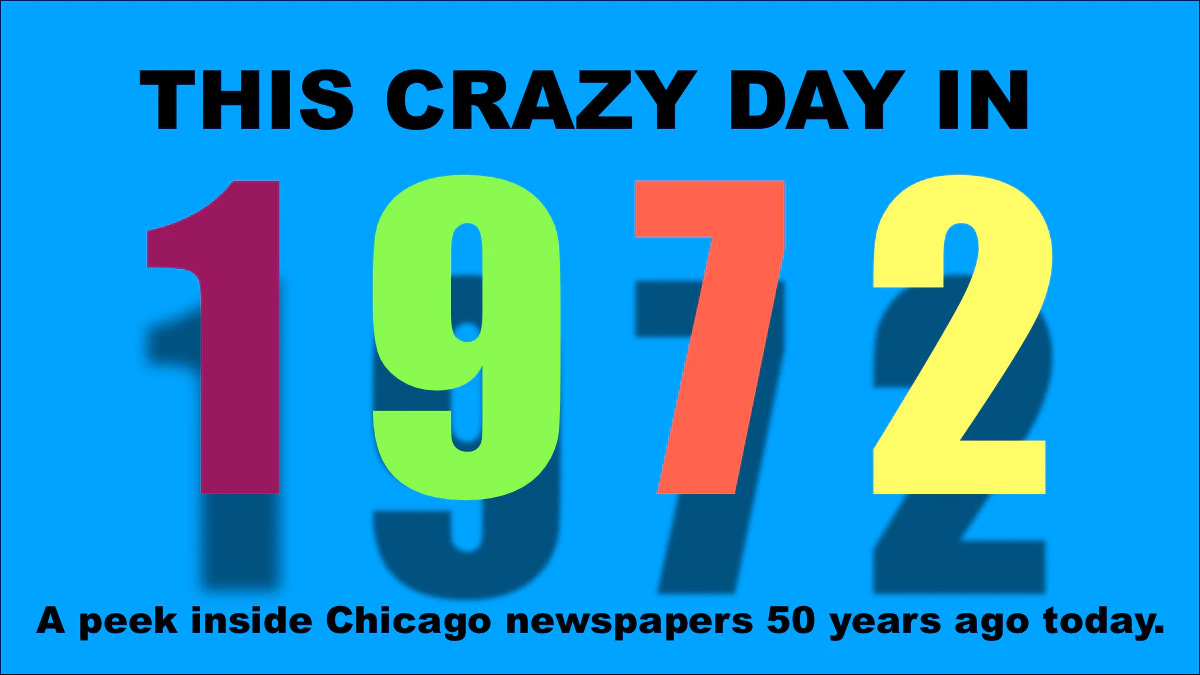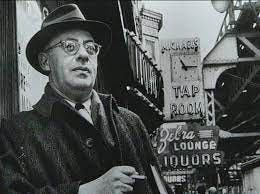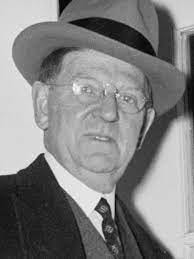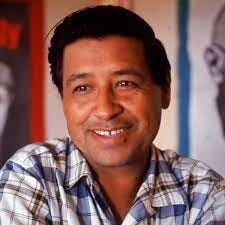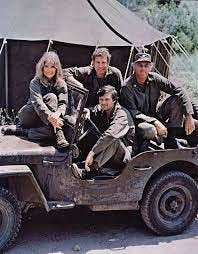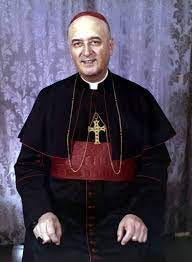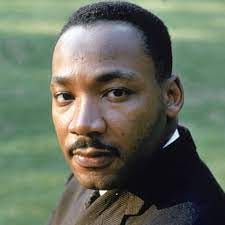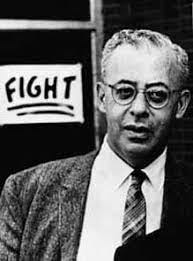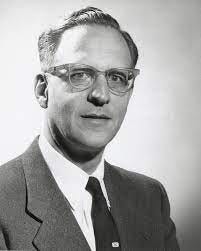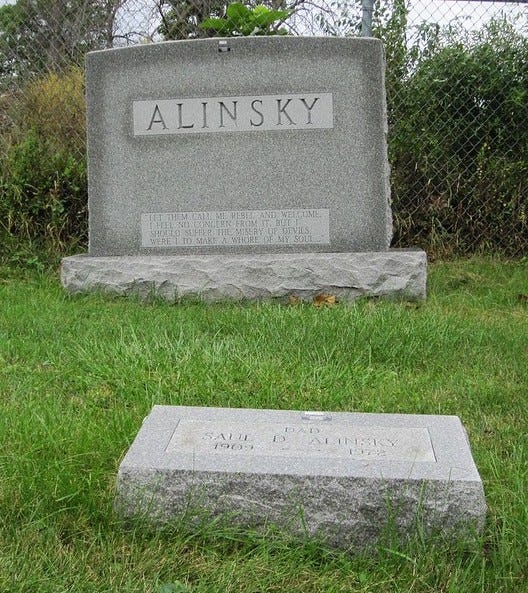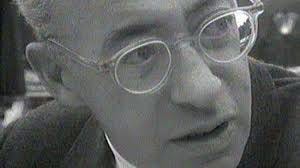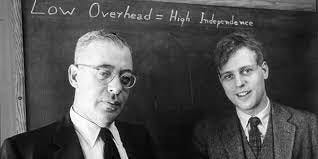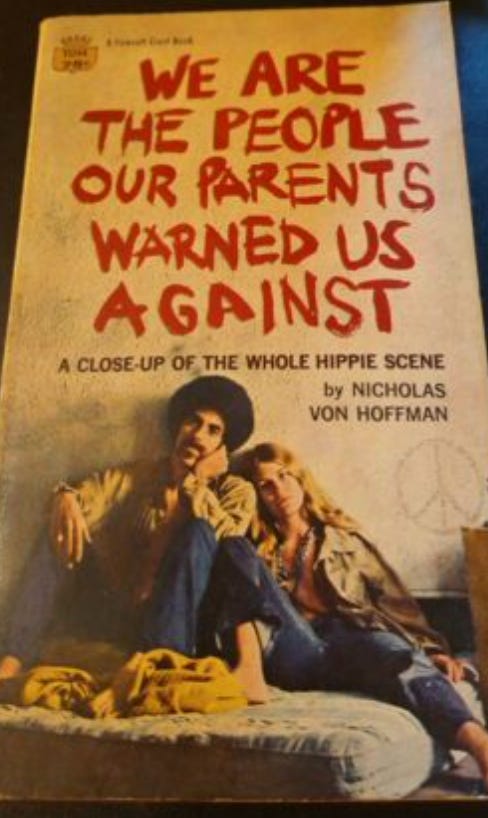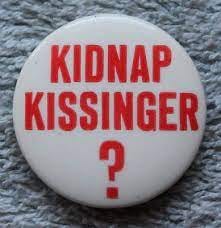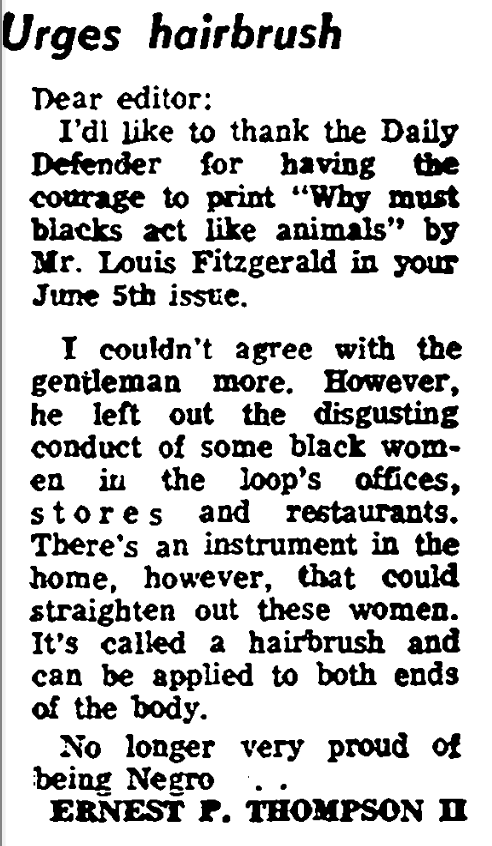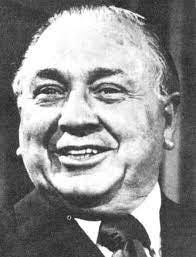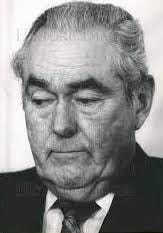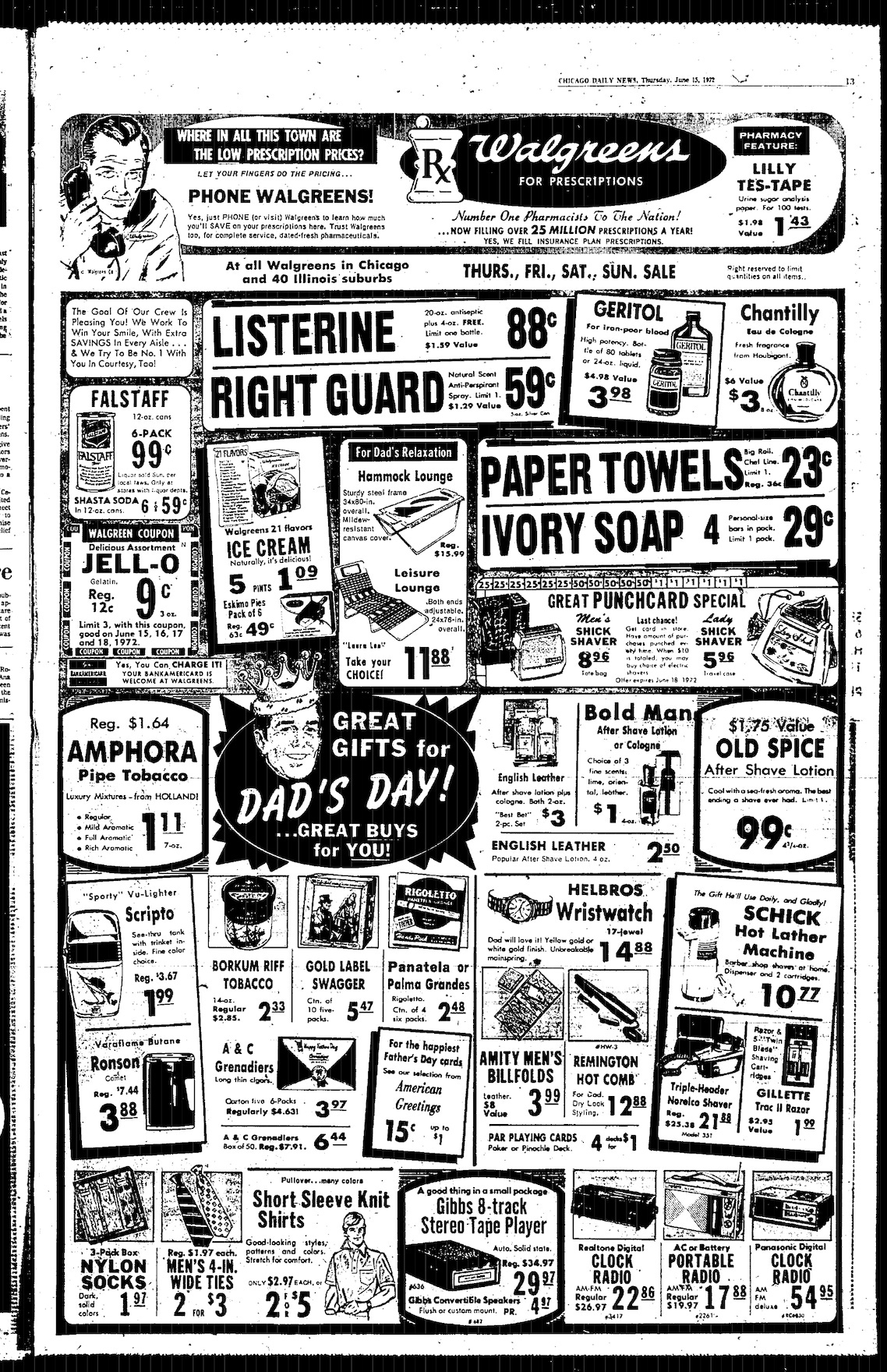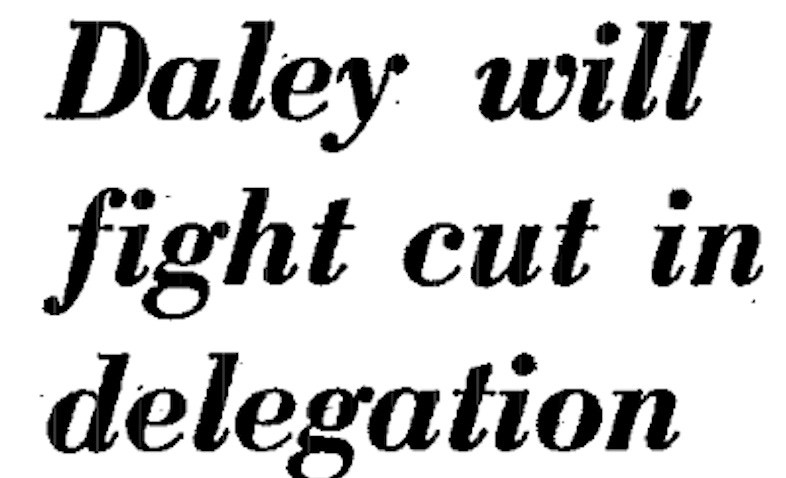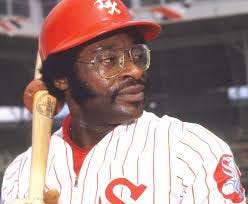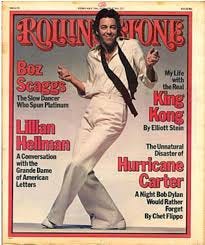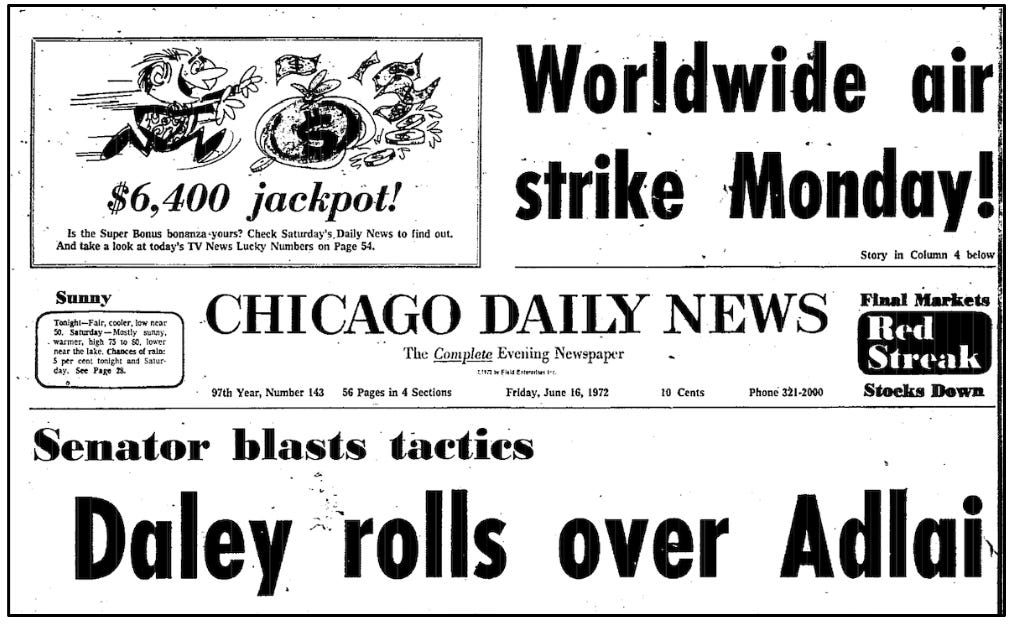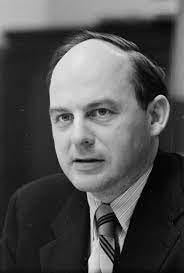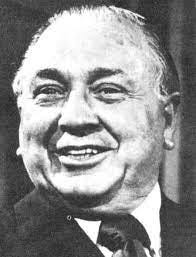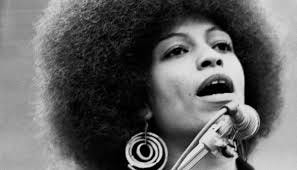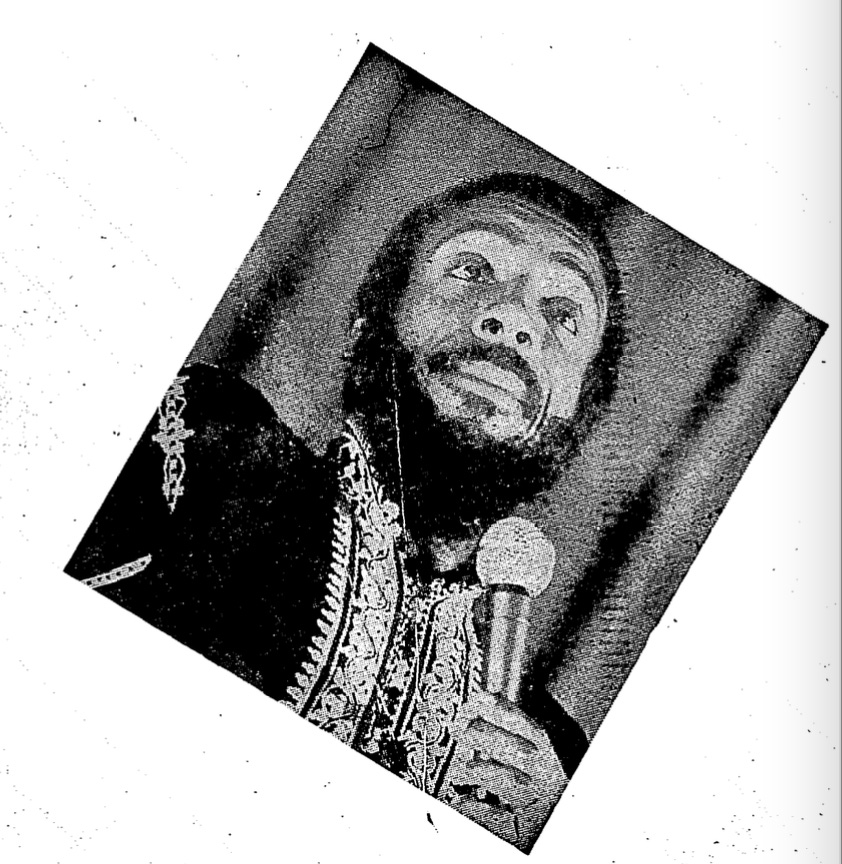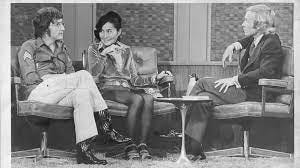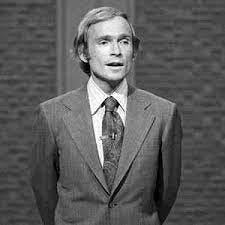THIS CRAZY DAY IN 1972: Fight! Fight! Mayor Daley v. Sen. Adlai Stevenson
Weekly compilation: June 12-18, 1972
To access all website contents, click HERE.
Why do we run this separate item peeking into newspapers from 1972? Because 1972 is part of the ancient times when everybody read a paper. Everybody, everybody, everybody. Even kids. So Steve Bertolucci, the 10-year-old hero of the novel serialized at this Substack, read the paper too—sometimes just to have something to do. These are some of the stories he read. Follow THIS CRAZY DAY on Twitter, @RoselandChi1972.
June 12, 1972
Chicago Daily News: Full page Father’s Day ad from True Value Hardware
Some things never change. Multiply everything by $6.75 to get 2022 prices.
June 12, 1972
Chicago Today
by Mary Leonard
“Mrs. Terri Weiner” is now “Ms. Terri Tepper,” but only after going to court.
In response to Terri’s lawsuit, Lake County Circuit Court Judge James Cooney ruled that per an 1874 act by the Illinois General Assembly, any Illinois resident who’s been in the state over six months can legally change their name—including married women.
Judge Cooney didn’t approve Terri Tepper’s simultaneous petition to declare “Ms.” a legal prefix, writing that “Ms.” “has not acquired a fixed meaning,” and the court doesn’t have the authority “to supply or fix a meaning.”
“He added, however, that there is no legal prohibition against a woman using ‘Ms.’ before her name if she so chooses” writes Mary Leonard.
“Terri said she was ‘delighted’ by the decision, and immediately then went about changing her voting registration and driver’s license identification. Her next confrontation, she said, will be with Marshall Field and Company’s credit card department.”
June 12, 1972
Chicago Daily Defender: Full page Kodak ad
June 12, 1972
Chicago Daily News: letter to the editor
This letter responds to the May 30 story “4,000 gals try for cops,” covered here.
June 13, 1972
Chicago Daily News
The index for today’s issue, which always runs at the bottom of the Daily News front page:
June 13, 1972
Chicago Today
no byline
“Saul David Alinsky, the man who gave voice to the voiceless and hope to those who knew only despair, is dead at 63.
“Of those who knew him and fought both for and against him, no two will have the same assessment of Alinsky’s life. That fact alone is an epitaph he would approve.”
What a great lede! Too bad we don’t know who wrote it.
Alinsky collapsed and died of a heart attack “while crossing a street in Carmel, Cal.”
Alinsky first became prominent in 1939 when he organized the Back of the Yards Council with Joseph Meegan, Today explains.
“The villain then was Mayor Edward Kelly, whose city hall forces crumbled before irate Back of the Yards residents demanding unheard of things, such as adequate garbage collection, better street lighting, strict building code enforcement and good police protection.”
Alinsky didn’t confine himself to neighborhood issues, Today points out. Citizens Action Program (CAP), the city-wide community group we often read about in 1972 opposing Mayor Daley’s Crosstown Expressway, began as a group organized by Alinsky’s Industrial Areas Foundation. CAP was first formed to fight pollution on the southwest side.
“Paul Booth, co-chairman of C.A.P., said, ‘The unique thing about Alinsky’s organizations was that they are capable of running under their own steam. C.A.P. is a metropolitan multi-issue peoples’ organization. It is a kind of model for the new kinds of groups he envisioned. Such groups will serve as a lasting monument to him.”
And Alinsky also didn’t confine himself to Chicago, traveling around the country to organize. “One of his prize students was Cesar Chavez, who successfully organized the Mexican-American grape pickers in California.”
Alinsky wrote “Reveille for Radicals” in 1947 during a jail term for his organizing activities, “for which the French philosopher Jacques Maritain called him ‘one of the few really great men of our century.’”
Alinsky’s “Rules for Radicals” came out in 1971, “a handbook for organization of the middle class, which he felt did not properly exercise the power at its disposal to lower taxes, fight pollution, and improve social conditions.”
Alinsky was “called a Red, rabble-rouser, and revolutionary” by the right, and a “reactionary by those on the left” who thought he wasn’t left enough, or ideological enough.
“Sidney Lens, a labor organizer and member of the Chicago Peace Council, was one of those who thought Alinsky was too far right,” writes Today.
“He was an innovative and daring man who managed to retain his ideals,” Lens told Today. “I had a lot of respect for him altho I disagreed with him on his theory that the middle class is victimized and I disagreed that a quota system should be used to end racial segregation. Alinsky was a good poker player—both figuratively and literally. He successfully carried labor’s organizing tactics into the community.’”
June 13, 1972
Chicago Today: Bruce Vilanch’s TV Report
“When we gathered here yesterday, the topic at hand was television comedy, the state of,” writes Bruce. “This is an important topic to air right now—yes, it is—because we are about to be inundated with a new brand of honest comedy, the likes of which you have seen before only on such shows as He and She, All in the Family and Sanford and Son.
“We are getting this new form largely because CBS has decided that honesty is what’s happening this season….They’ve decided this because All in the Family is such a smash.”
“Maude” is already in the works, Bruce writes, along with “M*A*S*H*, based wholly and robbed almost intact from the movie delight, and Bridget Loves Bernie, a warmer of ‘Abie’s Irish Rose’ via some Stiller and Meara routines”.
Nothing here “suggests originality” to Bruce, but there may be some “lowering of network taboo levels,” he predicts:
“On M*A*S*H*, we will see a man emerge from a tent full of nurses, zipping his fly. I tell you this now so that when it appears on your screen at 7 p.m. some Sunday in September you won’t suffer cardiac arrest.”
Another upcoming new show is lucky it’s going to follow the hit “Mary Tyler Moore Show” because it will need all the help it can get, Bruce predicts. The show’s premise “is probably too far advanced even for television.” He’s talking. about the first “Bob Newhart Show,” where the protagonist is a psychologist.
Beyond the psychology aspect, another problem “The Bob Newhart Show” might face is that, per Bruce, Bob and Emily Hartley actually “seem to be intelligent people, not Hollywood comics….At the beginning of one show, the couple are discovered in bed. One bed. They wake up. He feels like it. She doesn’t. He gets ticked. She sees that. Now she feels like it. They ask each other how much time they have to spare before they must get up. They figure eight minutes. They hop back in bed. Commercial.”
June 13, 1972
Chicago Daily News
by Lois Wille
Lois Wille’s wonderful obituary profile of Saul Alinsky begins with this quote from its subject:
“I guess that when you are constantly in the arena of conflict, you just don’t have the time to grow older. Life is conflict, and in conflict you’re alive…Sudden death, yes; but gradual age, no.”
“It happened just as he predicted,” writes Wille. “Saul David Alinsky, the tough but tender kid from Chicago’s West Side who became the nation’s most effective community organizer, died suddenly.
“He was 63, but he wasn’t old.
“He was arrogant, profane, idealistic, sentimental. But never old. He had too much fun doing his job.”
Alinsky’s focus was always with the poor and powerless, because “He was one of them. He was the son of Russian Jewish immigrants, raised in a flat in back of a store at 13th and Racine.”
“‘It was the slummiest of slums,’ he said.”
After decades of slummy conditions, and then decades of “urban renewal,” here is the corner of 13th and Racine today.
Alinsky collapsed “on a sidewalk” of a heart attack in Carmel, which Wille calls his “second home.” Alinsky traveled there frequently, she writes, “to visit his former wife Jean, crippled for many years by multiple sclerosis.”
“‘You know what it is about me that really burns people?’ [Alinsky] said after a blistering fight with the entire establishment of Rochester, N.Y. ‘It’s because I’m having a ball. I love what I’m doing. And that is blasphemy.’”
From Alinsky, Wille also gives us some of the best quotes about Chicago I’ve ever read:
“People who are looking for peace and tranquility—hell, the suburbs are their cemeteries. I love this city because it isn’t a drag, because it’s not boring. When we have bastards in this town, they’re the worst bastards. In a way, that can give you a little feeling of pride. Anyway, this is a town with action.”
Alinsky’s work in Back of the Yards impressed Marshall Field III, publisher of the
Sun-Times and Daily News, and Chicago’s Roman Catholic Bishop Bernard Sheil. They gave Alinsky the money to create the Industrial Areas Foundation, “a Chicago-based agency that contracts to build community organizations.”

IAF’s “greatest achievement, in Alinsky’s view,” came in 1960 when Chicago’s Roman Catholic Cardinal at that time, Archbishop Albert Meyer, gave IAF $150,000 to create The Woodlawn Organization.
“When hundreds of Woodlawn residents plucked dead rats from their kitchens and bedrooms and marched around City Hall waving them at passers-by, Mayor Richard J. Daley fumed,” writes Wille.
“‘Is that the way to be constructive?’ he said. ‘Is that the way to help your city?’
“But soon afterward, Daley managed to get federal money for a pioneering rat-control program.”
“Basically, (Alinsky) had two rules,” writes Wille. “Know precisely what you want, and be fairly certain you can get it before you take action.
“In 1966, he had several long, private talks with Rev. Dr. Martin Luther King, Jr. that developed into debates over these rules. The two considered forming a nationwide organization of the poor and powerless, but Alinsky came away frustrated.
“He wants to march for a philosophy, for an ideal,’ he said of Dr. King. ‘I want to march to get spoiled meat out of the corner grocery.’
“He felt Dr. King’s ‘open housing’ marches through white Chicago neighborhoods were disastrous. ‘All they did was make people mad,’ he said.
“Despite their tactical differences, Alinsky greatly admired Dr. King as a noble human being. But he detested latter-day activists like Yippie leaders Abbie Hoffman and Jerry Rubin.
“He thought they played with his techniques like mindless children. While the two were being lionized by liberals during the Conspiracy 7 trial in Chicago, Alinsky was asked what he thought they would be doing in 10 years.
“‘Vaudeville,’ he barked.”
As Alinsky and other white allies were less welcome in Black neighborhoods, writes Wille, he moved on. “But it wasn’t difficult to see he was hurt. Then he bounced back with a new approach. He formed the Industrial Areas Institute, a school for organizers at 528 N. Michigan. He stressed action among the middle class. He felt it was victimized by unfair tax structures, bad schools, pollution, unresponsive government and it was as powerless as the poor in the slums.
“One of his star pupils was the Rev. Leonard Dubi, who helped form the citywide Citizens Action Program (CAP) along Alinsky guidelines. CAP, Alinsky was convinced, will be the prototype for middle-class groups around the country—just as. TWO set the pattern for black and poor groups.”
Although Saul Alinsky obviously knew how to get publicity, CAP and Father Dubi are good examples of how Alinsky also stayed in the background, often an unseen driving force.
CAP is in 1972 news consistently right now due to its campaign against Mayor Daley’s Crosstown Expressway and opposition to tax increases. Father Dubi himself has just been the subject of two lengthy newspaper profiles—and yet, this is the first time in 1972 that coverage of CAP or Father Dubi has mentioned Saul Alinsky. In both profiles, one by Lois Wille herself, Father Dubi repeats almost verbatim Saul Alinsky’s view of the political powerlessness of Chicago’s white ethnics, but the pieces don’t mention Alinsky.

Wille ends with a quote from Rev. Arthur M. Brazier, the first president of TWO:
“I think Saul Alinsky was one of the greatest Americans of our time. He truly believed in democracy. Some people called him an agitator, but he was really a great American patriot.”
June 13, 1972
Chicago Today
June 14
Chicago Today
The 1972 frenzy of concern over the fate of The Dick Cavett Show on ABC is coming to a head. “It seems the network has given Cavett until July 28 to improve his ratings.”
That’s Nielsen ratings. Last night, former Tonight Show host Jack Paar—B.J., or “Before Johnny”— appeared on Dick Cavett and told viewers to call their local Nielsen office and say they were watching Dick Cavett.
Jack Paar gave out the phone number for Nielsen’s local office at 2101 W. Howard.
“The trouble is, nobody is at the Nielsen firm that time of night, except the night watchman janitor,” reports Chicago Today.
“And I got floors to sweep,” says the janitor.
“‘Oh Lord,’ he moaned this morning. ‘The phone rang all night long. I answered the first couple of times. After that, I ignored it. I got work to do.”
“Illinois Bell Telephone Co. officials said calls were backed up to the Nielsen number for about 10 minutes after Paar asked for the calls and gave the Chicago number.”
Have you checked out the novel at the heart of this site? Here’s Chapter One in the story of Steve Bertolucci, 10-year-old Roselander in 1972, and what becomes of him.
June 14, 1972
Chicago Daily News
by Jay McMullen
“The City Council paid tribute to radical activist Saul Alinsky Wednesday by refusing to name a park after him.”
Reporter Jay McMullen, future husband of future Mayor Jane Byrne, has been on the City Hall beat for 18 years already in 1972, and that lede reminds me that he deserves a hand now and then.
“‘We have just given him the greatest possible tribute,’ said Ald. Dick Simpson (44th), after the Council defeated his motion to create an Alinsky Park. ‘But I predict the thing we have just rejected will come to pass in future years.’”
Strangely, it has not. There is no Saul Alinsky Park, per the Chicago Park District website.
Simpson introduced the memorial resolution for Alinsky, which included a park proposal. Saul Alinsky Park, per Simpson’s resolution, would have no curfew, and would feature a permanent soapbox installed for “free speech of all sorts.”
The memorial resolution passed unanimously, but first Ald. Tom Keane deleted the park proposal portion. Keane is Mayor Daley’s floor leader and head of the finance committee, thus considered by many the second most powerful man in Chicago. Keane’s motion quashing Alinsky Park passed 35-8.
“Keane gave no reason for asking that this provision be deleted.”
“Ald. Leon Despres (5th) urged the Council to accept the full resolution,” writes McMullen. “The Woodlawn Organization, one of the strongest community groups organized by Alinsky, is in Despres’ ward.
“‘We owe him an enormous debt,’ Despres said. ‘There are lot of parks in the Woodlawn area that have only numbers. People in Woodlawn would be proud to have one of these numbers changed to Alinsky Park.”
But no.
Alinsky’s memorial service will be held at KAM-Isiaiah Israel Congregation at 1100 E. Hyde Park Blvd.
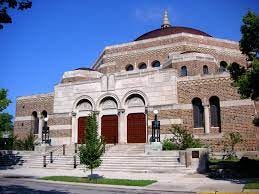
His cremated ashes will rest at Mount Mayriv Cemetery, 3600 N. Narragansett.
The inscription on Saul Alinsky’s tombstone is a quote from Thomas Paine:
“Let them call me rebel and welcome. I feel no concern from it, but I should suffer the misery of devils were I to make a whore of my soul.”
June 14, 1972
Chicago Today: editorial
“Saul Alinsky could have been called a complete cynic. With equal truth he could be called a complete idealist. You could make a case either way, depending on whether you were talking about his methods—which made very little allowance for faith in human goodness—or his goal, which was democracy.”
…. “Chicago, his home town, has much to remember him by—the Back of the Yards Council, The Woodlawn Organization, the Citizens Action Program, the Industrial Areas Foundation. But these are not monuments, they’re functioning, high-powered dynamos. Which is the only kind of memorial that would fit Saul Alinsky.”
Chicago Daily News: editorial
If anybody anywhere was better than Saul Alinsky at his chosen vocation, we have not heard of him…..Alinsky pioneered the civil rights movement in the North and was one of its most effective practitioners. Whatever progress there has been toward abating slums in Chicago and various other cities is traceable in important part to his persistent efforts. He got little thanks and a steady torrent of criticism and none of this daunted him.”
June 14, 1972
Chicago Tribune: editorial
Today the Tribune begins running a syndicated op-ed column by Washington Post reporter (and former Daily News reporter) Nicholas von Hoffman. But first, the Trib has to explain itself to readers in an editorial. Why?
Remember what Mike Royko had to say about the World’s Greatest Newspaper, before Rupert Murdoch bought the Sun-Times and Royko was forced to work in Tribune Tower himself:
In 1972, the Tribune was still slowly peeling off the dead skeletal fingers of owner/publisher Col. Robert McCormick, a man so ferociously conservative that he called President Herbert Hoover “the greatest state socialist in history.” The Colonel died in 1955. Still, in 1968, the Tribune called Robert F. Kennedy “Ho Chi Kennedy” for questioning the Vietnam war.
And in 1972, the Tribune reported on March 10 that the current skyjackings and planting of bombs on planes might be a worldwide Communist plot to disrupt “non-Communist air transportation systems” by training skyjackers at guerrilla flight schools in Cuba. Nobody else picked up on that Tribune exclusive, including the Trib, which never mentioned the Commie skyjacking plot again.
Burying the Colonel was a long process—see the Chapter 3 Notes Chapter “Chicago Newspapers Circa 1972” for more detail. But in 1972, current Tribune editor Clayton Kirkpatrick is shaking off the Colonel bit by bit.
Adding Nicholas von Hoffman to the Tribune’s op-ed page is a good example of Kirkpatrick’s changes, and astoundingly so on this exact day, because von Hoffman worked with Saul Alinsky in Chicago for ten years before joining the Daily News in 1963. Next week, we’ll read von Hoffman’s tribute to Alinsky in the pages of the Tribune, of all places.
In 2010, von Hoffman will write “Radical: A Portrait of Saul Alinsky,” which covers other facets of Alinsky that didn’t make it into the 1972 papers, or hadn’t happened yet—such as Alinsky’s early work as a budding criminologist embedding himself with the Capone organization, and how his tactics have been studied and used by activists on every point of the political spectrum, including the rightwing Tea Party.
Nicholas von Hoffman was hired away from the Daily News by the Washington Post in 1966, where he remained for ten years, ruffling feathers there and on CBS’ “Sixty Minutes.” According to his obituary in the Post, “Mr. von Hoffman's best-known comment on the show was also his last, resulting in his firing by "60 Minutes" creator Don Hewitt.

"‘The President is like a dead mouse on the American family kitchen floor,’ he said in July 1974, in the waning days of the Richard M. Nixon administration. ‘The question is: Who is going to pick it up by the tail and drop it in the trash?’”
Nicholas Von Hoffman would go on to write many more books, including “Citizen Cohn” and “Capitalist Fools: Tales of American Business, from Carnegie to Forbes to the Milken Gang.” He died in 2018.
Back in 1972, here’s the Tribune’s explanation to its readers on why the paper is about to publish a guy who spent the summer of 1967 hanging around with hippies in San Francisco, resulting in his book “We Are the People Our Parents Warned Us Against”:
“Nicholas von Hoffman makes his bow today as a syndicated columnist on our Perspective page,” writes the Tribune. “We predict that his provocative and controversial style of commentary will shock and anger some of our readers. It will delight others. Seldom, if ever, will it bore any, whether friend or foe.”
The Tribune admits to its readers that von Hoffman “carries a liberal label,” but hastens to add that he “sometimes turns on his normal partisans with waspish words.”
“‘When a newspaper man joins up with a cause,’ von Hoffman wrote recently, ‘he risks serving higher loyalties than his work and his own opinion; he is in danger of becoming a spokesman: that is, a person who no longer conceives of his duty to tell all there is to tell, but to make his side look good, to emphasize what’s alluring and skip over what’s hard to explain…
“‘The newspaper columnist, even more than the reporter, has an obligation to be a grouchy, suspicious, nasty, introspective monk, a horrid, raggedy thing no faction would care to capture.’”
The Tribune concludes, speaking directly to its readers:
“Maybe you will like him; maybe you will loathe him. But if you read him your perception of the world will be a little sharper, and that is what good writing is all about.”
June 14, 1972
Chicago Tribune
“Marge Tabankin, the president of the National Student Association, recently had an unparalleled chance to see her tax dollars at work. She’s just back from a week in North Viet Nam, where she was bombed 17 times by her fellow countrymen.”
The National Student Association, writes von Hoffman, is the largest independent student group in the U.S. and has opposed the Vietnam war for many years. He says it’s not surprising, then, that she and three other representatives were invited to visit Hanoi—though we never do hear exactly who invited them.
Just as the students arrived via cab in Hanoi, a U.S. bombing raid started. A public address system with speakers on every block directed people to shelters. Tabankin said in every city she visited in North Vietnam, “one-man bomb shelters with cement covers that you pull over you have been dug every three feet. You’re safe in them unless you get a direct hit, and because there is only one person in each of them fewer people are killed when there is a direct hit. Our driver kept swerving over to let us get out and into the shelters” before finally taking them to their hotel, where they hid in a larger shelter.
The students visited the War Crimes Commission building, a kind of museum. “They have a special antiwar movement room where the Kidnap Kissinger buttons are already in a glass case,” Tabankin told Hoffman.
Note: The buttons refer to the Harrisburg Seven, a group including radical priest Father Philip Berrigan, recently found not guilty in 1972 of, among other things, allegedly conspiring to kidnap Henry Kissinger. In our timeline, Kissinger is still a national security aide to President Richard Nixon, not yet Secretary of State, even though he’s globe-trotting and meeting secretly all over the place with Chinese, Russians, and North Vietnamese.
“The War Crimes Commission has an exhibit that shows where your tax money goes,” writes von Hoffman. “‘It was,’ Marge said, ‘like a museum of American technology. Unbelievable! Every kind of weapon, and antipersonnel bomb….You could see the Honeywell-Minneapolis label on them.”
“In the village of Phuc Loc, 11 miles outside Haiphong, she saw what the B-52s do— ‘Sixty-some-odd people died that night. I talked to an 11-year-old boy who lost eight members of his family. After the all-clear sounded he couldn’t even put pieces of his mother and father back together.’”
Marge Tabankin is convinced the North Vietnamese cities are being systematically destroyed, and Von Hoffman says the North Vietnamese expect all their cities to be decimated eventually.
“So the Pentagon high-accuracy ‘smart bombs’ either have a low I.Q. after all,” concludes von Hoffman, “or [Nixon’s Secretary of Defense] Melvin Laird is lying again when he says there are no civilian targets.”
June 14, 1972
Chicago Daily Defender
Responses begin to the trenchant column last week by Louis Fitzgerald, a South Sider who began writing letters to the Defender in January and will soon become an official Defender columnist. See last week under June 10 for background on Louis Fitzgerald, including the link to a documentary he instigated on racial change in Chatham in the early ‘60s.
Although the Defender will often print letters excoriating Louis Fitzgerald, they only printed two positive responses to Fitzgerald’s June 5 letter/column headlined ““Why must blacks act like animals?”
“The actions by some blacks in the downtown area of Chicago is downright disgusting if not outright ignorant,” Fitzgerald wrote.
Further down: “Blacks who would like to live decently are running away from blacks just as whites have been and are doing. It is not difficult to understand why blacks, too, are running…Stable businesses are moving and relocating to other areas because of threats, robberies, broken windows and the like….No one can tell me we have been programmed to be destructive….While we cry for equality on one hand we exert inequality by being destructive!”
June 14, 1972
Chicago Today
by Joel Weisman
“Mayor Daley and Sen. Stevenson are engaged in one of the most significant games of political brinkmanship in recent years—and it could result in a confrontation Friday,” writes Chicago Today political editor Joel Weisman.
“That’s when Illinois’ 170 Democratic National Convention delegates meet in Springfield to select a chairman for the delegation.”
Mayor Daley has been chairman of the Illinois state delegation to Democratic national conventions since 1958.
1958.
Daley and Stevenson both claim they have the votes. Word is if the vote was secret, it could go to Stevenson. In a public vote, some Stevenson supporters would likely not have the guts to vote against Mayor Daley,
“‘I’ve never seen the mayor back down from a good fight in my life and I certainly don’t think this is the time he will,’ said County Board President George W. Dunne, one of Daley’s top political advisors. ‘Besides, I think the mayor will win with a few votes to spare.’”
Joel Weisman thinks Stevenson is picking this fight in order to re-establish himself as the leading Illinois progressive Democrat, which he kind of lost after backing Lt. Gov. Paul Simon’s unsuccessful campaign against Dan Walker for the Democratic gubernatorial nomination against Republican Gov. Richard Ogilvie.
June 14, 1972
Chicago Daily Defender: ad for Angela Davis appearance
Angela Davis was acquitted last week of murder and kidnapping. See the first June 5 item for the AP’s succinct wrap-up of the trial for more details. Now she’s on a national speaking tour, with the second stop at Arie Crown Theater this week.
June 15, 1972
Chicago Daily News
More great stuff for Dad! Multiply everything by $6.75 to get 2022 prices.
Jun 15, 1972
Chicago Daily Defender: Letter to the editor
See May 26, 27, and 28 for details on recent vandalism and arson on homes bought by Black Chicagoans moving into West Pullman/Roseland and Beverly.
If you’re a regular THIS CRAZY DAY reader, you’ll probably want to follow Mike Royko 50 Years Ago Today too.
June 15, 1972
Chicago Daily News
by Charles Nicodemus
Last week at the Democratic state convention, Mayor Daley “forced through” a rule change doubling the number of Illinois’ at-large delegates to the national convention from 10 to 20, each getting 1/2 vote rather than a full vote, writes the Daily News’ political editor, Charles Nicodemus.
“He said he did so in order to provide delegate seats for several veteran Democrats—including National Committeeman Jacob Arvey” who didn’t win a delegate seat in the June 2 election.
The national Democratic committee’s general counsel, Joseph Califano, says the expanded delegation won’t fly—it’s against the written rules.
“John P. Touhy, vice chairman of the party’s [Illinois] state central committee, said [Califano’s] ruling…is ‘just another lawyer’s opinion.’”
Chicago Today
by Joel Weisman
On that at-large delegate question, Chicago Today’s political editor Weisman notes that “Tuesday, CHICAGO TODAY spelled out in detail the violation of the national party rules in the Daley plan. But the Mayor bristled at a City Hall news conference. ‘There’s no question that it [the plan] is legal,’ he said.”
But in complete contradiction with the Daily News’ Charles Nicodemus, Weisman thinks Daley will back down on the delegate expansion.
Meanwhile, “Heavy pressure is being applied to the state’s 90 uncommitted delegates to the Democratic National Convention to elect Mayor Daley as the delegation chairman for the fifth consecutive time,” writes Weisman.
“On orders from Daley, Congressman Dan Rostenkowski (D, Ill), chief of the Chicago House delegation in Washington, yesterday quickly returned to Chicago to join other party leaders seeking to line up the necessary delegates to give Daley a victory over Sen. Stevenson.”
“Rostenkowski, Cook County Board President George W. Dunne, Sheriff Richard J. Elrod, and Daley’s legislative leaders reportedly are pulling out all the stops to assure Daley the chairmanship, which he has held since 1958.”
1958.
June 15, 1972
Chicago Daily Defender
“I was not among those present at Chicago White Sox Park on Sunday, June 4, when 51,904 fans attended a Sox-Yankee doubleheader. But I can dig it! The crowd, I mean—the largest White Sox home crowd since July 27, 1954.”
Note: See last week’s second June 5 item for a complete look at that halcyon day in Sox history! This June 4th game is so emblematic of Dick Allen’s arrival in Chicago that it provides the title for the wonderful new biography of Dick Allen by John Owens and David J. Fletcher, edited by George Castle: “Chili Dog MVP: Dick Allen, the 1972 Sox and a Transforming Chicago.”
“I can dig it because it says a great deal about Baseball, 1972. It says:
“If an organization produces a winning team, fans will support it.
“Black stars, like white stars, have great box office appeal.
“It is untrue that white fans will shun a team merely because a ball park is located in a predominantly-black neighborhood. That’s a cop-out used by bigots.”
….“When the White Sox hired qualified, new front office executives; hired a manager, Chuck Tanner, who possesses a winning attitude; and brought in a Rich, Richie, Dick Allen, things picked up at the gate. The June 4 crowd was reminiscent of the crowds the Cleveland Indians drew in 1948 when Satchel Paige was pitching.”
….“Chicago always has been a great baseball town. There was, for example, a Sunday 60 years ago when the White Sox, the Cubs, and the Negro Chicago American Giants all played at home. Each club drew well. But the Negro team drew best of all!”
Note: See the Chicago History Podcast episode #504, “Chicago Baseball: Rube Foster and American Giants” for more background on the Chicago American Giants. The Giants played for a time at the now-vanished South Side Park after the White Sox moved into Comiskey Park, and at Comiskey too after 1941 when the Sox were out of town.
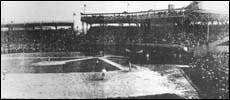
….“I don’t know how many black fans were among the 51,904 who attended the June 4 doubleheader. But I do know that there is a tremendous, if latent, black baseball fandom in Chicago, and the team which does the ‘right thing’ will have the fact proven beyond doubt.”
….“It was perfectly fitting that Dick Allen won the second game of the June 4 doubleheader with a pinch-hit, three-run homer because Dick Allen, a black superstar, has created a great deal of White Sox excitement this year.”
June 15, 1972
Chicago Today
“‘Fillmore’ is the best rockumentary since ‘Woodstock’ and the only thing that keeps it from being better is a smaller subject,” declares Mary Knoblauch.
“The film details the last week of rock impresario Bill Graham’s Fillmore West in San Francisco, intercutting performances with sequences of Graham trying to talk groups into or out of appear.
“Thru all his cajoling, we get a picture of the reasons for his closing Fillmore—the swelled egos of the groups, the undependability of their commitments to show up, and—above all—the greed that turned big name rock into just another commercial establishment.”
Knoblauch calls the camera work “sensational,” showing that “technology has made a leap since ‘Woodstock.’”
“The mood is very different from other rockumentaries—it is not the exuberant celebration of ‘Woodstock’ or the artificiality of ‘Concert for Bangladesh,’ or the hyped agony of ‘Gimme Shelter.’
“Instead it is a warm, elegant farewell to the world of flower children and music that had Fillmore West as its cathedral.”
And you can watch it for free on YouTube:
June 16, 1972
Chicago Tribune
Gene Siskel is less impressed.
“Last summer the Fillmore closed, and Life magazine, among others, chose to view its closing as The Death of Rock,” writes Siskel. “Listen, it filled space.”
Siskel gives us an update on promoter Bill Graham: While Graham claimed he closed the Fillmore East and West due to “avarice on the part of the musicians and rowdyism on the part of the audiences,” in fact the two venues were about to lose big money, says Siskel. So Graham closed both, and now operates instead from the Winterland, “an auditorium with a larger seating capacity and a more attractive lease.”
Siskel enjoys the film’s behind-the-scenes shenanigans of the musicians shilling for more money and better billing before blowing off the shows altogether, or trying to—Boz Scaggs in particular.
“Less effective is the footage of the last few concerts of the 19 songs performed by 13 groups, fewer than five generate any interest,” writes Siskel.
But Siskel figures it will be news to rock fans to see what jerks their idols are backstage:
“Feeding tunes to the Love Generation, you see, is big business.”
For Younger Readers unfamiliar with early rock history, the Fillmores provided the venues for some of the best early live rock albums. That includes—to truly name just a few—The Allman Brothers’ “At Fillmore East” and “Fillmore West ‘71,” “Aretha Live at the Fillmore West,” and Jimi Hendrix’s “Live at the Fillmore East.”
June 16, 1972
Chicago Tribune: Letter to the editor
And the anticipated avalanche of reader laments over Nicholas von Hoffman begins!
June 16, 1972
You saw this coming, right?
From Joel Weisman’s story, we hear about specific threats against supporters of U.S. Sen. Adlai Stevenson over Mayor Daley for heading the Illinois delegation to the Democratic National Convention.
Even though Stevenson claimed he had 90 votes—four more votes than he needed to beat Mayor Daley—he’s dropping out of this fight.
Some of Weisman’s examples:
“Delegate Michael Bakalis, state superintendent of education, reportedly received word the appropriation for his office would be held up or cut in the legislature.”
“Several delegates who are attorneys were warned that some critical clients could decide to take their law business elsewhere if they didn’t vote for Daley.”
“One ambitious northern Illinois delegate was warned he would never be slated for state office.”
June 16, 1972
Chicago Today: Bruce Vilanch’s TV Report
“Things are popping on the Dick Cavett front. And I don’t mean buttons. [Who writes your material, Vilanch? Mae West?]
“A study undertaken by Gilbert Youth Research, Inc. has revealed that, contrary to everyone’s best beliefs, more college students prefer Johnny Carson than Cavett.
“The study was administered one year ago, before the CBS Late Movie had taken the lead in nighttime viewing, so the competition factors have all changed. You will recall that Merv Griffin was CBS’ entry in that period.”
Back then, 34% of the surveyed college students watched Johnny, 25%. watched movies, and 16% watched Dick Cavett.
This is unsettling to Cavett supporters, Bruce reports—apparently there’s a widely known “Cavett theory of collegiate viewing” where Dick Cavett is doing great with college students, but it doesn’t show up in the Nielsen ratings.
June 17, 1972
Chicago Today
by Barbara Reynolds
“‘This is what the power of the people is all about,’ said Angela Davis, but her words were drowned out by the roar of 3,000 applauding, shouting persons in McCormick Place’s Arie Crown Theater.
“Led to the stage by guards and placed behind a bulletproof glass shield for security, the black revolutionary thus began a talk that lasted about 55 minutes. It was her second speech since her acquittal June 4 of murder-kidnap-conspiracy charges in California.”
The audience went through metal detectors to enter the theater—far more, we know here, than anyone needs to do to get on a plane in 1972—and paid $2.50 to $3.50 a ticket, which is $17-$18 in 2022 money.
“‘Chicago leads the nation in police terrorist activities,’ she said in her talk. She called for the defeat of State’s Atty. Edward V. Hanrahan in the November election.
“If millions can come together to work for my defense, why can’t we build a movement to defend the black community against racist cops with billy clubs?”
June 17, 1972
Chicago Today
by Mark Clark, Springfield Bureau
“If ‘Paddy’ Bauler were here, he’d say ‘Illinois just ain’t ready for reform.’
“The comment was made facetiously, but sheepishly, by a Chicago Democrat after the organization meeting of the Illinois delegation to the Democratic National Convention.
“Mayor Daley and his loyalists had just completed a virtual sweep of the key posts in the delegation after slapping down the strongest challenge to their leadership in five conventions.”
U.S. Sen. Adlai Stevenson withdrew his name from consideration, saying “bitterly, ‘tactics used [on Daley’s behalf] disrupt the party and frustrate the rising expectations of many for a voice in the conduct of their own affairs.’”
Plus, Daley placed five of his own people on the 6-member Illinois contingent to the national Credential Committee—and all five Daleyites are among the disputed expanded number of at-large delegates, not elected in the June 2 election.
June 18, 1972
Chicago Today: Dorothy Storck*
**Dorothy Storck is one of the amazing Chicago Today writers you wish had turned up as a daily Tribune columnist after Today folded in 1974. We’ll take a closer look at Dorothy Storck as soon as possible.
by Dorothy Storck
You read that right—Chicago Today ran two separate reviews of Angela Davis by two different reporters. This one is a longer opinion piece, and Dorothy Storck’s unequivocal opinion is that Angela Davis is boring.
“Friday night at McCormick Place she was trundled out behind her bullet-proof glass cage to an audience which was achingly receptive.
“She gave them—thru the cage’s microphones—a classroom lecture in embryonic Marxism.
“It went on for one hour and ten minutes and it was replete with phrases like: ‘microcosmic preview of fascism’ and ‘socialistic, anti-capitalistic reworking of history.’
“Angela Davis was—would you believe it?—boring.
“If this is revolution, they better begin handing out the No-Doz pills.”
Storck concludes it would have been way more interesting to hear instead from two currently prominent Chicago women, Rev. Willie Barrow of PUSH and Ald. Anna Langford— “full-throated women with plenty to say, and they keep saying it.”
Per Storck, Rev. Willie Barrow “looked bloomingly stunning in her flowered evening gown Friday night as she cajoled and exhorted cash money ($3,000) out of the crowd to pay for Angela’s defense fund”.
“Willie Barrow—well, she’s something else. Listen to her once at any of those PUSH fund-raising meetings, or the times she talks about boycotting stores which sell rotten meat to poor, black customers and you’ve got an earful.”
Here’s Rev. Willie Barrow’s biography at The History Makers website, which includes videotaped interview segments. Barrow worked closely with Rev. Martin Luther King in Selma, and was one of the leaders who convinced King to come to Chicago.
Barrow helped found King’s SCLC’s Chicago chapter of Operation Breadbasket, moving on to PUSH when Breadbasket leader Rev. Jesse Jackson quit and began PUSH late in 1971. (Among many items on Jesse Jackson leaving Breadbasket and. founding PUSH, see TCD1972 on December 14, 15, 16, 17 and 18.)
Barrow was known as “The Little Warrior,’ and began fighting for civil rights as a 12-year-old in Texas when she led the fight to allow Black students on school buses. She died in 2015, when Rev. Jesse Jackson said of her, “She was fearless.”
Bonus: The “Chicago Tonight" remembrance for Rev. Willie Barrow.
June 18, 1972
Chicago Tribune
June 17-18, 1972
Chicago Daily Defender
by Jacqueline Moore
“Father’s Day does not generate the amount of interest, celebration and excitement of Mother’s Day, but Dad is certainly due his ‘day in the sun.’ This is especially true, we believe, in the case of black fathers, who have suffered under the myth that black father are predominantly absent from the home.”
For Father’s Day, the Defender runs a full page of pictures of Dick Gregory with an article by Women’s Editor Jacqueline Moore. (Note: There’s no headline.)
“We chose Dick Gregory, comedian, lecturer, militant black leader and father of nine children to symbolize ‘The Black Father 1972.’ To his two boys and seven girls, Dick Gregory is just ‘Daddy’; the smaller ones can’t understand how they can see him on television while he’s right there at home. He insists that the children be vegetarians, even the babies have their vegetables blended by Mrs. Gregory. Although Lillian Gregory runs the house, Dick is there helping to mold the characters of the future black citizens who are today these laughing, playful nine kids. (Note: The pictures with the article are only of Dick Gregory.)
“Dick said that he enjoys fatherhood very much. Commenting on the image that the black man ‘splits’ from the family, he said, ‘Everybody outlives the black man—the white woman, the white man, the black woman. He ain’t hiding’; he’s in the graveyard.’”
June 18, 1972
Chicago Today: Bruce Vilanch’s TV Report
This Dick Cavett guy must be pretty important! Bruce is writing about him twice in one week.
“Here is an absolutely startling bit of information,” writes Bruce.
“Letters CAN help save Dick Cavett.
“I got that from Jim Duffy, who is president of the ABC Television Network, the network that refused to renew the talk show host’s contract last April. Instead of a renewal, they gave him until July 18 to improve his ratings. If no improvement is shown by that date, the contract will be forever dropped and the show will disappear from the air Sept. 29.”
Duffy says he’s gotten lots of impressive letters on Dick Cavett.
“But let me explain to you what our real problem with Dick is,” he says.
There’s two things. First, the ratings. Dick Cavett started in December 1969, says Duffy, and only last fall “did he actually surpass the ratings Joey Bishop had been getting in that slot.”
Then, the CBS Movie got rolling in the same time slot, and Cavett’s ratings dipped again.
Second is the network station affiliates. It’s always been an issue for ABC, writes Bruce. “While CBS and NBC each have over 200 stations affiliated with them, ABC has always trailed at around 150. This has made for a vicious circle. National ratings are classically lower on ABC.”
That means local affiliates are tempted to use their own local shows instead of network offerings, and make more money off local advertising rather than getting 12% of the network ad revenue from a national show. The fewer the local affiliates who run a show, the lower the ratings. And so on.
“These guys see Cavett getting a 1 rating and Carson getting a 9. They want out,” says Duffy. “For that reason, I would advise viewers to write to the station manager in their city.”
June 17-18, 1972
Chicago Daily News: editorial
Now that Mayor Daley has resoundingly won the battle against U.S. Sen. Adlai Stevenson to head Illinois’ state delegation to the upcoming national Democratic convention in Miami, writes the Daily News, “we hope he will see fit to help push the Equal Rights Amendment through the Illinois House.”
Because ERA lost another vote in the Illinois House, a pawn in the political game between Daley and Stevenson.
“One of the two main sponsors of ratification, Rep. Eugenia Chapman of Arlington Heights, also happens to be one of the delegates who was backing Sen. Adlai Stevenson against the mayor. Word filtered down to Mrs. Chapman that several Daley stalwarts in the House probably would withdraw their support for the amendment if she persisted in. going along with the Stevenson challenge.”
Sure enough—when the vote came “on the eve of the delegation’s caucus in Springfield,” seven Daley Democrats changed their votes to “No.”
“Had they voted the other way, the amendment would have been ratified there and then.”
The Daily News urges the mayor to be “forgiving and generous” in “the flush of victory,” and get the ERA passed when it comes up for a vote again in a few days.
June 18, 1972
Chicago Daily News: full page ad
Polk Brothers refreshingly, if weirdly, bucks the Father’s Day advertising trend. Presumably they meant well.
June 18, 1972
Get ready!
Two weeks ago, the International Federation of Airline Pilots threatened a worldwide pilot strike on June 19 if real changes weren’t made to stop skyjacking. Guess what? The only thing that’s happened in the past two weeks is attempts to stop the strike, rather than attempts to stop skyjacking.
A federal judge just denied a request from the Air Transport Association to stop the strike, so it looks like it’s on.
“The prospect of one million stranded passengers thruout the non-Communist world and a loss of $27 million to United States airlines seems likely tomorrow as almost 50,000 pilots in 60 countries prepared to strike for 24 hours to back up their demands for stricter antihijacking laws.
“An estimated 31,000 persons are scheduled to fly between the United States and Europe tomorrow, when the shutdown is to begin at 1 a.m. [Chicago time].”
June 18, 1972
Chicago Tribune
by Peter Negronida
“Saul Alinsky was ready for America long before America was ready for him,” opens Peter Negronida in this lengthy piece taking up most of the cover of today’s Trib Sunday Perspective section. A short bio identifies Negronida as a Trib reporter who’s covered Alinsky’s community organizations.
We’ve already learned most of the basic facts about Alinsky in other items earlier in the week, so I’ll just include some new points and great quotes in Negronida’s piece.
Alinsky’s tactics were “unorthodox, outrageous, and sometimes dirty—all aimed at hitting the Establishment where it hurt and keeping if off balance,” he writes.
“‘If the end doesn’t justify the means, what the hell does?’ Alinsky used to ask.”
Legendary 5th Ward Ald. Leon Despres attended the University of Chicago with Alinsky, who made it there on scholarship from a desperately poor upbringing by Russian Jewish immigrants on the West Side.
“As a student, he was uncomfortably serious and passionately interested in sociology,” Despres told Negronida. “His intensity was almost frightening.”
“There was personal tragedy in Alinsky’s life,” writes Negronida. “His first wife, Helene, drowned in 1947 while she was trying to save two children.
“‘He was profoundly in love with her,’ recalled Ald. Despres, ‘and the loss hit him hard. He was quite a while recovering from it.’”
Longtime Alinsky friend Msgr. John J. Egan, “former director of urban affairs for the [Chicago] archdiocese and now on the faculty at the University Notre Dame,” tells Negronida: “There was a deep loneliness in Saul that was funneled into a burning unrest over poverty amid affluence and oppression in a land dedicated to freedom.”
Alinsky was often charged with being a Communist or Marxist, and Negronida writes that “hurt Alinsky deeply, according to associates.”
“‘He was a true liberal with a love of freedom and a respect for the individual,’ recalled Msgr. Egan. ‘He said he criticized the United States because he wanted it to live up to its promise. He loved it so much that he wanted to fix it.’”
Alinsky’s first organizing came in Back of the Yards. In 1939, he was working at Joliet State Prison and researching juvenile delinquency when he met Joe Meegan, head of the Back-of-the-Yards Council, then working as a park supervisor.
“‘He said he wanted to attack the causes of the problems,’ Meegan recalled, ‘like the fact that the stockyards were paying workers only 39 cents an hour at the time.’
“Alinsky used his contacts in the labor movement, and Meegan sought help from the Roman Catholic Archdiocese; and by July 16 [1939] their organizing efforts led to a rally of 16,000 people addressed by such men as John L. Lewis of the United Mine Workers and Bishop Bernard Sheil of the archdiocese.
“‘The meat packers knew they had a new force to contend with,’ Meegan said, ‘and three days later they gave the workers a 17-cent pay rase.’”
“Peter Martinez, a young graduate of Alinsky’s [Industrial Areas Institute] said it was ‘exciting just to be with him—even if just for a cup of coffee.’”
“The public Alinsky, on the other hand, could be a holy terror.
“He larded his public statements with so much profanity that the news media often could not relay his words to their readers and listeners.”
“Among the outrageous tactics he had actually used were dumping garbage at the home of an alderman, parading around City Hall with rats, and picketing the suburban hole of a slum landlord.”
Negronida, per his 1983 Tribune obituary by Kenan Heise, was a Chicago native who served four years in the Air Force before joining the Tribune in 1963 as a neighborhood reporter, going on to general assignment and education before moving in 1977 to the production side. When he died at the untimely age of 55, Negronida was production editor.
Here at TCD1972, we’ve read Negronida’s work covering the current spate of vandalism on the homes of Black Chicagoans moving into West Pullman/Roseland and Beverly, on May 26 , May 27 and May 28.
Did you dig spending time in 1972? If you came to THIS CRAZY DAY IN 1972 from social media, you may not know it’s part of the novel being serialized here, one chapter per month: “Roseland, Chicago: 1972” —FREE. It’s the story of Steve Bertolucci, 10-year-old Roselander in 1972, and what becomes of him. Check it out here.



